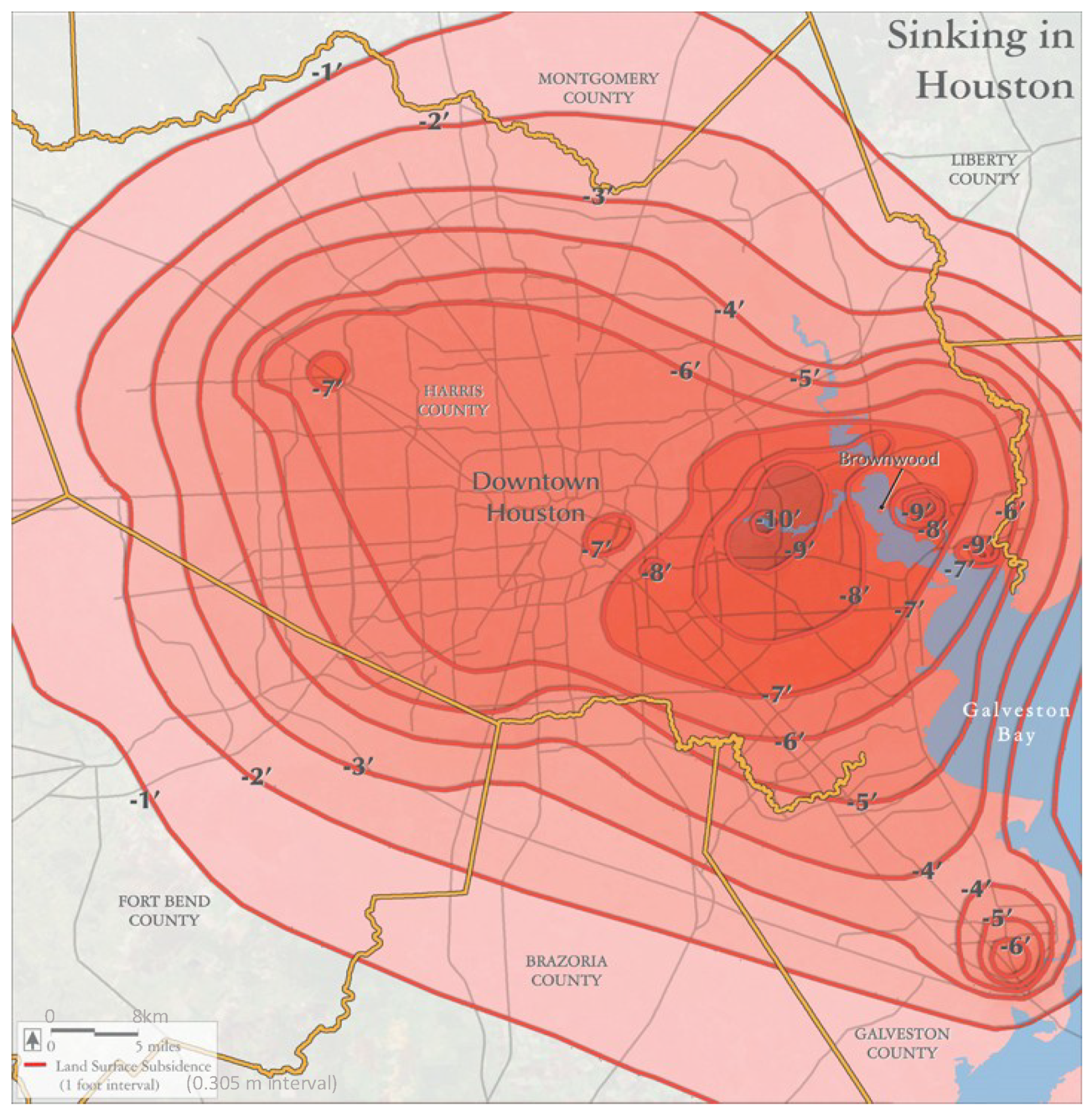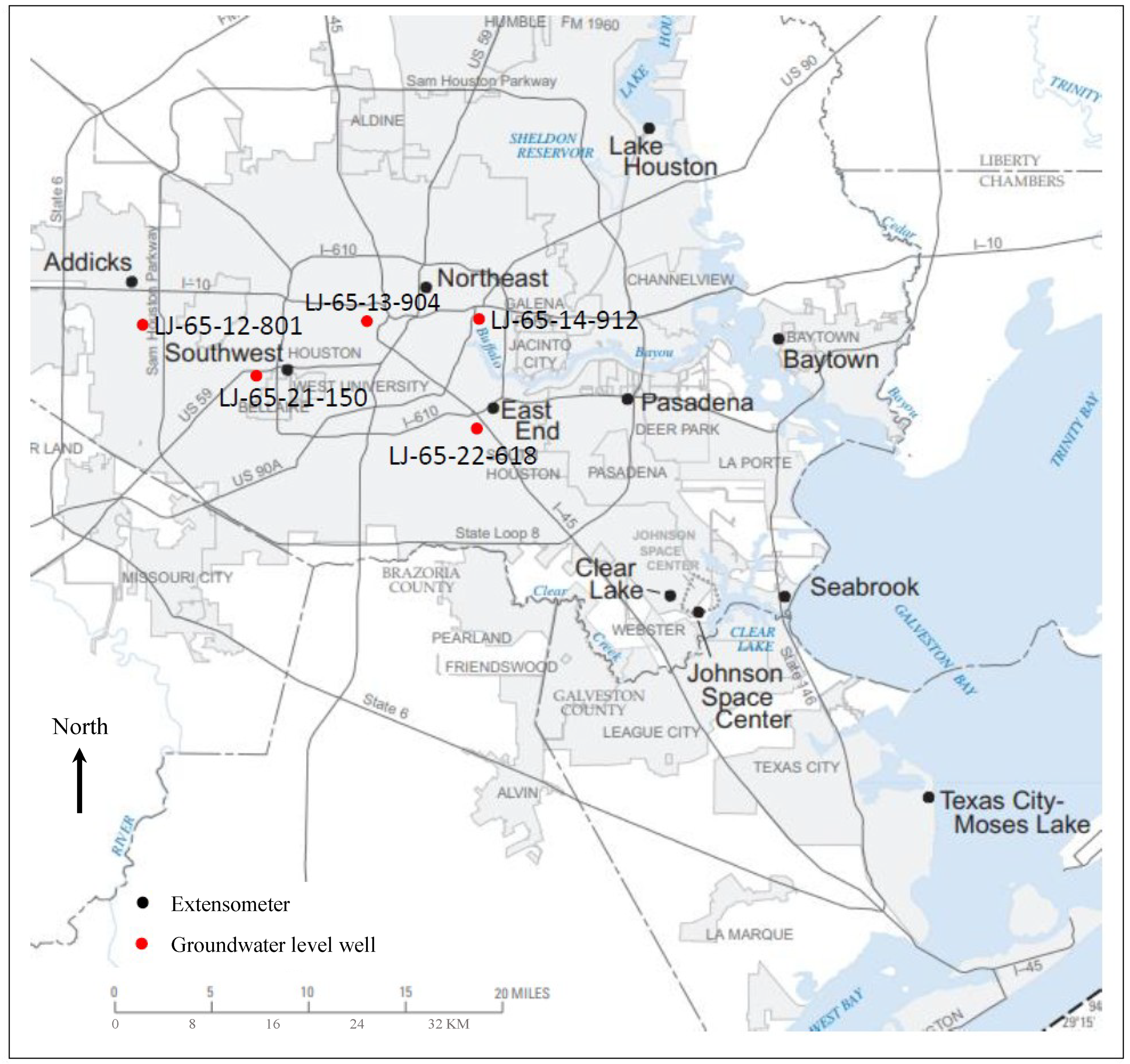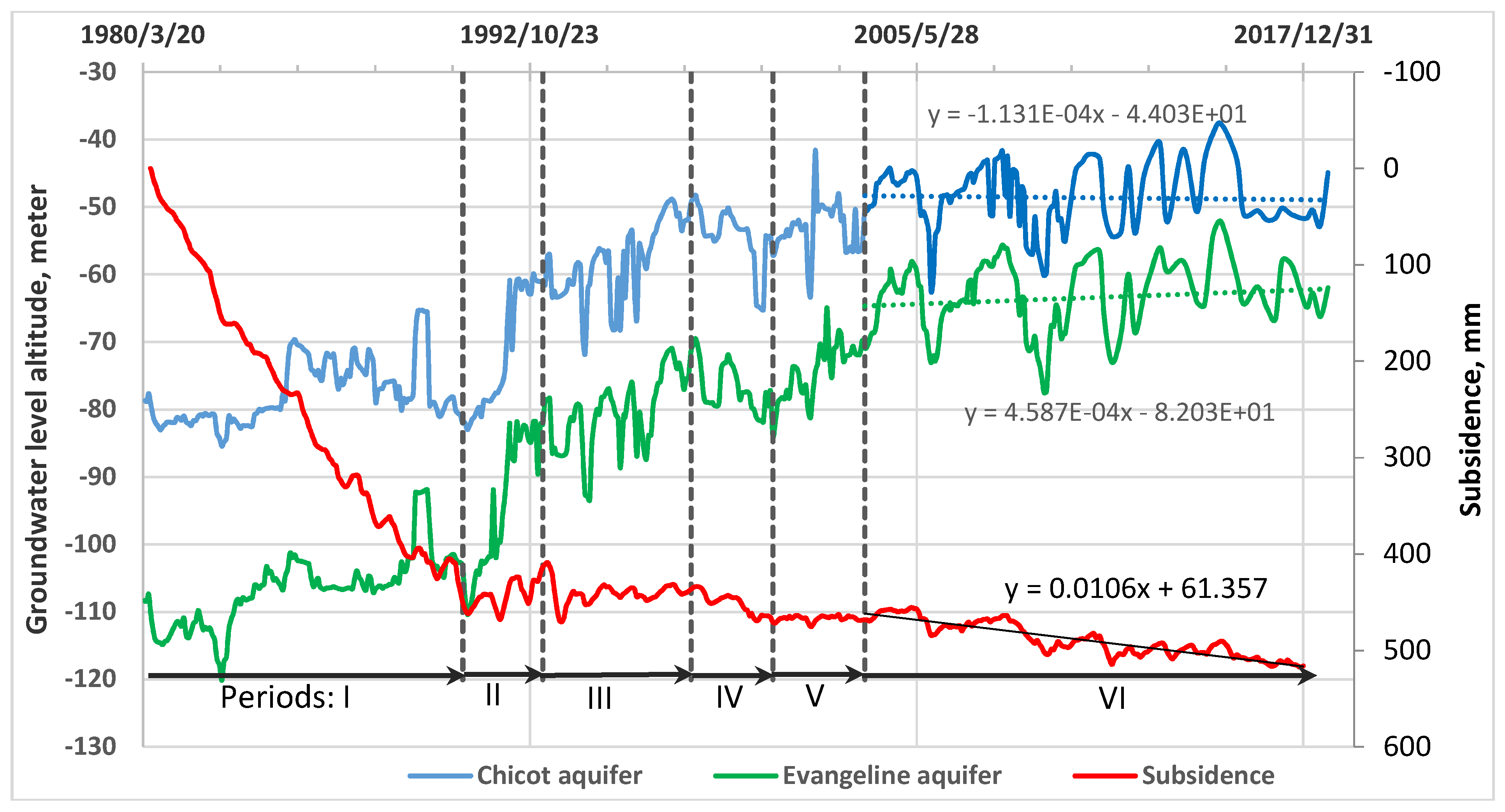Groundwater Level Change Management on Control of Land Subsidence Supported by Borehole Extensometer Compaction Measurements in the Houston-Galveston Region, Texas
Abstract
:1. Introduction
2. Compressible Aquifer System
3. Borehole Extensometer
4. Analysis Methodology
5. Results
5.1. Groundwater Withdrawal
5.2. Groundwater Level Changes
5.3. End of Primary Inelastic Compaction
6. Conclusion
Author Contributions
Funding
Acknowledgments
Conflicts of Interest
References
- Galloway, D.L.; Jones, D.R.; Ingebritsen, S.E. Land Subsidence in the United States; U.S. Geological Survey: Reston, VA, USA, 1999.
- Galloway, D.L.; Sneed, M. Analysis and simulation of regional subsidence accompanying groundwater abstraction and compaction of susceptible aquifer systems in the USA. Bol. Soc. Geol. Mex. 2013, 65, 123–136. [Google Scholar] [CrossRef]
- Pratt, W.E.; Johnson, D.W. Local subsidence of the Goose Creek oil field. J. Geol. 1926, 34, 577–590. [Google Scholar] [CrossRef]
- Qu, F.; Lu, Z.; Zhang, Q.; Bawden, G.W.; Kim, J.W.; Zhao, C.; Qu, W. Mapping ground deformation over Houston – Galveston, Texas using multi-temporal InSAR. Remote Sens. Environ. 2015, 169, 290–306. [Google Scholar] [CrossRef]
- Coplin, L.S.; Galloway, D.L. Houston-Galveston, Texas: managing coastal subsidence. In Land Subsidence in the United States; U.S. Geological Survey: Reston, VA, USA, 1999; pp. 35–46. [Google Scholar]
- Kasmarek, M.C. Hydrogeology and Simulation of Groundwater Flow and Land-Surface Subsidence in the Northern Part of the Gulf Coast Aquifer System, Texas, 1891–2009; Scientific Investigation Report 2012-5154; U.S. Geological Survey: Reston, VA, USA, 2013.
- Kasmarek, M.C.; Ramage, J.K.; Johnson, M.R. Water-Level Altitudes 2016 and Water-Level Changes in the Chicot, Evangeline, and Jasper Aquifers and Compaction 1973–2015 in the Chicot and Evangeline Aquifers, Houston–Galveston Region, Texas; U.S. Geological Survey: Reston, VA, USA, 2016.
- Sellards, E.H.; Adkins, W.S.; Plummer, F.B. The Geology of Texas: Volume 1 Stratigraphy. Univ. Texas Bull. 1932, no. 3232. 1007. [Google Scholar]
- Baker, E.T. Stratagraphic and Hydrogeologic Framework of Part of the Texas Coastal Plain; Texas Department of Water Resources: Austin, TX, USA, 1979. [Google Scholar]
- Meyer, W.R.; Carr, J.E. A Digital Model for Simulation of Groundwater Hydrology in the Houston Area, Texas; Texas Department of Water Resources: Austin, TX, USA, 1979. [Google Scholar]
- Baker, E.T. Hydrology of the Jasper Aquifer in the Southeast Texas Coastal Plain; Texas Department of Water Resources: Austin, TX, USA, 1986. [Google Scholar]
- Chowdhury, A.H.; Turco, M.J. Geology of the Gulf Coast aquifer, Texas. In Aquifers of the Gulf Coast of Texas; Mace, W.F., Davidson, R.E., Angle, S.C., Mullican, E.S., Eds.; Texas Water Development Board: Austin, TX, USA, 2006; pp. 23–50. [Google Scholar]
- Lambeck, K.; Esat, T.M.; Potter, E.K. Links between climate and sea levels for the past three million years. Nature 2002, 419, 199–206. [Google Scholar] [CrossRef] [PubMed]
- Kasmarek, M.C.; Robinson, J.L. Hydrogeology and Simulation of Groundwater Flow and Land-Surface Subsidence in the Northern Part of the Gulf Coast Aquifer System, Texas; Scientific Investigation Report 2004-5102; U.S. Geological Survey: Reston, VA, USA, 2004.
- Kasmarek, M.C.; Ramage, J.K.; Houston, N.A.; Johnson, M.R.; Schmidt, T.S. Water-Level Altitudes 2015 and Water-Level Changes in the Chicot, Evangeline, and Jasper Aquifers and Compaction 1973–2014 in the Chicot and Evangeline Aquifers, Houston–Galveston Region, Texas; Scientific Investigations Map 3337; U.S. Geological Survey: Reston, VA, USA, 2015.
- Carr, J.E.; Meyer, W.R.; Sandeen, W.M.; McLane, I.R. Digital Models for Simulation of Groundwater Hydrology of the Chicot and Evangeline Aquifers along the Gulf Coast of Texas; Report 289; Texas Department of Water Resources: Austin, TX, USA, 1985.
- Kasmarek, M.C.; Lanning-Rush, J. Water-Level Altitudes 2003 and Water-Level Changes in the Chicot, Evangeline, and Jasper Aquifers and Compaction 1973 – 2002 in the Chicot and Evangeline Aquifers, Houston-Galveston Region, Texas; Open-File Report 2003-109; U.S. Geological Survey: Reston, VA, USA, 2003.
- Gabrysch, R.K. Groundwater Withdrawal and Land-Surfae Subsidence in the Houston-Galveston Region, Texas, 1906-80; Open-File Report 82-571; Texas Department of Water Resources: Austin, TX, USA, 1984; pp. 1–62.
- Tolman, C.F.; Poland, J.F. Groundwater infiltration, and ground-surface recession in Santa Clara Valley, Santa Clara County, California. Eos Trans. AGU 1940, 21, 23–34. [Google Scholar] [CrossRef]
- Helm, D.C. Field-based computational techniques for predicting subsidence due to fluid withdrawal. Geol. Soc. Am. Rev. Eng. Geol. 1984, 6, 1–22. [Google Scholar]
- Poland, J.F.; Green, J.H. Subsidence in the Santa Clara Valley, California—A Progress Report; U.S. Geolorical Survey Water-Supply Paper 1619-C; U.S. Government Printing Office: Washington, DC, USA, 1962; p. 16.
- Holzer, T.L. History of the aquitard-drainage model in land subsidence case studies and current research. In Land Subsidence Case Studies and Current Research: Proceedings of the Dr. Joseph F. Poland Symposium on Land Subsidence; Association of Engineering Geologists: Belmont, CA, USA, 1998; pp. 7–12. [Google Scholar]
- Riley, F.S. Mechanics of aquifer systems-The scientific legacy of Joseph F. Poland. In Land Subsidence Case Studies and Current Research: Proceedings of the Dr. Joseph F. Poland Symposium on Land Subsidence; Association of Engineering Geologists: Belmont, CA, USA, 1998; pp. 13–27. [Google Scholar]
- Liu, Y.; Helm, D.C. Inverse procedure for calibrating parameters that control land subsidence caused by subsurface fluid withdrawal: 1. Methods. Water Resour. Res. 2008, 44. [Google Scholar] [CrossRef] [Green Version]
- Green, J.H. Compaction of the Aquifer System and Land Subsidence in the Santa Clara Valley, California, U.S. Geologi- cal Survey Water-Supply Paper 1779-T; U.S. Geological Survey: Reston, VA, USA, 1964; p. 11.
- Poland, J.F.; Ireland, R.L. Land Subsidence in the Santa Clara Valley, California, as of 1982: U.S. Geological Survey Professional Paper 497-F; U.S. Geological Survey: Reston, VA, USA, 1988; p. 61.
- Poland, J.F. Land subsidence in the San Joaquin Valley and its effect on estimates of groundwater resoruces. Comm. Sub Terranean Waters Publ. 1960, 52, 325–335. [Google Scholar]
- Miller, R.E. Compaction of an Aquifer System Computed from Consolidation Tests and Decline in Artesian Head, U.S. Geological Survey Professional Paper 424-B; U.S. Geological Survey: Reston, VA, USA, 1961; pp. B54–B58.
- Riley, F.S. Analysis of borehole extenso meter data from central California. Land Subsid. 1969, 2, 423–431. [Google Scholar]
- Helm, D.C. One-dimensional simulation of aquifer system compaction near Pixley, Calif., part 1. Constant parameters. Water Resour. Res. 1975, 11, 465–478. [Google Scholar] [CrossRef]
- Poland, J.F.; Lofgren, B.E.; Ireland, R.L.; Pugh, R.G. Land Subsidence in the San Joaquin Valley, California as of 1972: U.S. Geological Survey Professional Paper 43 7-H.; U.S. Geological Survey: Reston, VA, USA, 1975; p. 78.
- Ireland, R.L.; Poland, J.F.; Riley, F. Land Subsidence in the San Joaquin Valley, California as of 1980: U.S. Geological Survey Professional Paper 43 7-I; U.S. Geological Survey: Reston, VA, USA, 1984; p. 93.
- Helm, D.C. One-dimensional simulation of aquifer system com- paction near Pixley, California: 2. Stress-dependent parameters. Water Resour. Res. 1976, 12, 375–391. [Google Scholar] [CrossRef]
- Helm, D.C. Estimating Parameters of Compacting Fine-Grained Interbeds within a Confined Aquifer System by a One-Dimensional Simulation of Field Observations; IAHS Publ.: Wallingford, UK, 1976; pp. 145–156. [Google Scholar]
- Terzaghi, K. Principles of soil mechanics, IV-Settlement and consolidation of clay. Eng. News-Record 1925, 95, 974–978. [Google Scholar]
- Helm, D.C. Field verification of a one-dimensional mathematical model for transient compaction and expansion of a confined aquifer system. In Verification of Mathematical and Physical Models in Hydraulic Engineering; American Society of Civil Engineers: Reston, VA, USA, 1978. [Google Scholar]
- Epstein, V.J. Hydrologic and Geologic Factors Affecting Land Subsidence near Eloy, Arizona. Water Resour. Invest. Rep. 1987, 87, 4143. [Google Scholar]
- Hanson, R.T. Aquifer-System Compaction, Tucson Basin and Avra Valley. Water Resour. Invest. Rep. 1989, 88, 4172. [Google Scholar]
- Sneed, M.; Galloway, D.L. Aquifer-System Compaction and Land Subsidence: Measurements, Analyses, and Simulations—the Holly Site, Edwards Air Force Base, Antelope Valley, California. Available online: https://pubs.usgs.gov/wri/2000/wri004015/pdf/wrir004015.pdf (accessed on 14 May 2019).
- Pope, J.P.; Burbey, T.J. Multiple-aquifer characterization from single borehole extensometer records. Ground Water 2004, 42, 45–58. [Google Scholar] [CrossRef] [PubMed]
- Liu, Y.; Helm, D.C. Inverse procedure for calibrating parameters that control land subsidence caused by subsurface fluid withdrawal: 2. Field application. Water Resour. Res. 2008, 44, 1–16. [Google Scholar] [CrossRef]
- Terzaghi, K. Settlement and consolidation of clay. In Principles of Soil Mechanics; McGraw-Hill: New York, NY, USA, 1925; Volume IV, pp. 874–878. [Google Scholar]
- Gabrysch, R.K.; Bonnett, C.W. Land-Surface Subsidence in the Houston-Galveston Region, Texas; Texas Water Development Board: Austin, TX, USA, 1975. [Google Scholar]
- Fitch, B. Kynch theory and compression zones. AIChE J. 1983, 29, 940–942. [Google Scholar] [CrossRef]
- Taylor, D.W. Research on Consolidation of Clays; Publication 82; Massachusetts Institute of Technology: Cambridge, MA, USA, 1942. [Google Scholar]
- Been, K.; Sills, G.C. Self-weight consolidation of soft soils: An experimental andtheoretical study. Geotechnique 1981, 31, 519–535. [Google Scholar] [CrossRef]










| Given Time Period Δt in Equation (4), Years | ||||||
|---|---|---|---|---|---|---|
| Ds1 | 5 | 10 | 20 | 30 | 40 | 50 |
| 1.0% | 495 2 | 990 | 1980 | 2970 | 3960 | 4950 |
| 0.5% | 995 | 1990 | 3980 | 5970 | 7960 | 9950 |
| 0.1% | 4995 | 9990 | 19,980 | 29,970 | 39,960 | 49,950 |
| Extensometer | Well # | Aquifer | Secondary Consolidation Appearance Period | Groundwater Level Trend | Secondary Consolidation Rate | ||||
|---|---|---|---|---|---|---|---|---|---|
| Depth, m | Starting Date | Ending Date | m/day * | m/yr | mm/day | mm/yr | |||
| Texas City | 224 | KH-64-33-901 | Chicot | 1/24/2008 | 1/14/2017 | −8.73 × 10−5 | −0.03 | 2.222 × 10−4 | 0.08 |
| Seabrook | 863 | LJ-65-32-519 | Chicot | 1/25/2008 | 1/14/2017 | −2.77 × 10−5 | −0.01 | 8.317 × 10−3 | 3.04 |
| LJ-65-32-630 | Evangeline | −7.67 × 10−5 | −0.03 | ||||||
| Space Center Clear Lake Deep | 223 | LJ-65-42-422 | Chicot | 1/25/2007 | 12/20/2017 | 9.09 × 10−5 | 0.03 | 5.062 × 10−3 | 1.85 |
| 936 * | LJ-65-42-424 | Evangeline | 6.79 × 10−5 | 0.02 | 3.033 × 10−3 | 1.11 | |||
| Baytown Shallow | 131 | LJ-65-16-933 | Chicot | 5/26/2005 | 5/28/2009 | 3.82 × 10−4 | 0.14 | 3.630 × 10−3 | 1.33 |
| Baytown Deep | 1475 | LJ-65-16-931 | Evangeline | 1/11/2007 | 9.21 × 10−5 | 0.03 | 5.956 × 10−3 | 2.17 | |
| Addicks | 550 | LJ-65-12-729 | Chicot | 10/1/2007 | 5/15/2014 | 2.73 × 10−4 | 0.10 | 2.327 × 10−2 | 8.49 |
| LJ-65-12-726 | Evangeline | 0.00 | 0.00 | ||||||
| East End | 421 | LJ-65-22-623 | Chicot | 7/27/2007 | 1/13/2015 | −2.72 × 10−4 | −0.10 | 4.926 × 10−3 | 1.80 |
| LJ-65-22-622 | Evangeline | 5.64 × 10−4 | 0.21 ^ | ||||||
| Northeast | 550 | LJ-65-14-745 | Chicot | 1/4/2008 | 3/1/2011 | 5.27 × 10−4 | 0.19 | 1.150 × 10−2 | 4.20 |
| LJ-65-14-746 | Evangeline | 1.07 × 10−3 | 0.39 ^^ | ||||||
| Pasadena | 863 | LJ-65-23-321 | Chicot | 1/5/2007 | 1/5/2011 | 3.76 × 10-6 | 0.00 | 6.032 × 10−3 | 2.20 |
| LJ-65-23-326 | Evangeline | 2/6/2007 | 3/30/2010 | 8.39 × 10−4 | 0.31 ~ | ||||
| Lake Houston | 719 | LJ-65-07-902 | Chicot | 1/7/2004 | 4/4/2007 | 8.38 × 10−5 | 0.03 | 3.760 × 10−3 | 1.37 |
| LJ-65-07-908 | Evangeline | 1.24 × 10−4 | 0.05 | ||||||
| Southwest | 719 | LJ-65-21-229 | Chicot | 9/18/2003 | 10/18/2018 | −1.13 × 10−4 | −0.04 | 1.042 × 10−2 | 3.80 |
| LJ-65-21-227 | Evangeline | 4.59 × 10−4 | 0.17 | ||||||
© 2019 by the authors. Licensee MDPI, Basel, Switzerland. This article is an open access article distributed under the terms and conditions of the Creative Commons Attribution (CC BY) license (http://creativecommons.org/licenses/by/4.0/).
Share and Cite
Liu, Y.; Li, J.; Fang, Z.N. Groundwater Level Change Management on Control of Land Subsidence Supported by Borehole Extensometer Compaction Measurements in the Houston-Galveston Region, Texas. Geosciences 2019, 9, 223. https://doi.org/10.3390/geosciences9050223
Liu Y, Li J, Fang ZN. Groundwater Level Change Management on Control of Land Subsidence Supported by Borehole Extensometer Compaction Measurements in the Houston-Galveston Region, Texas. Geosciences. 2019; 9(5):223. https://doi.org/10.3390/geosciences9050223
Chicago/Turabian StyleLiu, Yi, Jiang Li, and Zheng N. Fang. 2019. "Groundwater Level Change Management on Control of Land Subsidence Supported by Borehole Extensometer Compaction Measurements in the Houston-Galveston Region, Texas" Geosciences 9, no. 5: 223. https://doi.org/10.3390/geosciences9050223
APA StyleLiu, Y., Li, J., & Fang, Z. N. (2019). Groundwater Level Change Management on Control of Land Subsidence Supported by Borehole Extensometer Compaction Measurements in the Houston-Galveston Region, Texas. Geosciences, 9(5), 223. https://doi.org/10.3390/geosciences9050223






